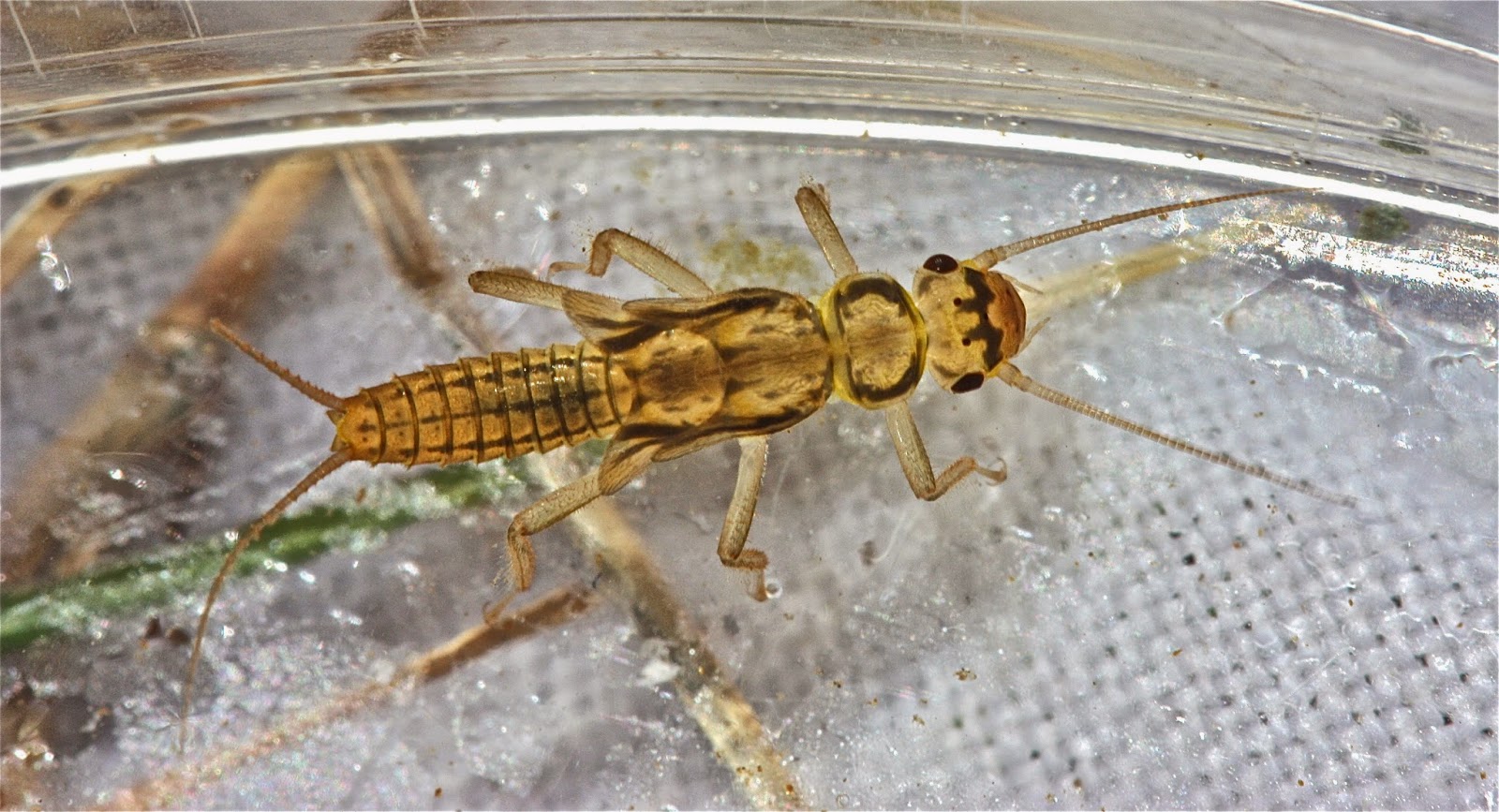As I mentioned last week, the Rapidan River is already chock-a-block full of these little nymphs. It's the most common Perlodid stonefly we see in our streams. From January to April they take over the leafpacks, hatching in large numbers in March and April to the delight of fly fisherman. The Rapidan River must have spectacular hatches of "Yellow Sallies."
I've posted numerous entries (2/15/12, 2/16/12, 4/30/13, 4/7/14) discussing the problem of what these nymphs should be called. If we lived in the midwest, we'd call them Isoperla namata. But Isoperla namata does not occur in the east: the Ozarks and the midwest. But since our nymphs look just like namata, Beaty -- in his 2011 edition of "The Plecoptera of North Carolina" (p. 24) -- went with Isoperla nr. namata (Isoperla "nearly" namata) as the label to use.
In the northeast, these nymphs are called Isoperla montana (for "mountains") and Beaty later concluded that I. montana does indeed occur in our part of the country. Still, there might be other species with nymphs that look much the same. How about Isoperla montana/Isoperla sp. (i.e., either montana or a species that hasn't been named)?
Last year, Beaty informed me that we have at least two species that show up as this nymph: Isoperla montana and Isoperla kirchneri. The adult of I. kirchneri has now been described (S. W. Szczytko and B. C. Kondratieff, A Review of the Eastern Nearctic Isoperlinae (Plecoptera: Perlodidae) with the description of twenty-two new species, pp. 126-133): we're still waiting for the details on the nymph.
Quite a mess -- but the entomologists are making progress. While we wait for the "nymph" section of Szczytko and Kondratieff to be published, let me review the forms of this nymph that I've found in the streams that I visit. There are three.
__________________
Number 1. Unquestionably the most common form of this nymph that I see looks like the one at the top of the page: that includes every nymph that I've ever seen in the Rapidan River. To compare this with other forms, we have to look at two critical features. Look at the head.
On this nymph -- on all forms of this nymph -- there is a dark transverse band on the head. Here, that band extends down to touch the lateral ocelli.
Feature two: at the very back of the head, there are two dark bars or stripes that reach from the ecdysial suture (right behind the ocelli) to the occiput (the very back of the head).
________________
Number two. Now look at this nymph from South River,
and this one from Buck Mt. Creek.
We still see the dark transverse band and the bars/stripes at the back of the head. Missing? -- the points of extension between that band and the ocelli.
Is that a significant difference? Does it indicate a different species? I don't know: let's hope we find out. But I've found this form in a number of streams -- streams in which I've also found form #1 -- e.g. Buck Mt. Creek, South River, and Powell's Creek.
________________
Number three. And this form is unique. Where I have found it, it's the only form that I've found. And, I've only seen it in Sugar Hollow's small, pristine, headwater streams, higher in elevation than the other streams that I visit.
Do you see the difference? On these nymphs, there are no dark bars or stripes running back from the lateral ocelli to the very back of the head. (The pattern on the pronotum also looks a bit different.)
But I did note one thing on interest in the Szczytko and Kondratieff study. The adult form of Isoperla kirchneri -- as I noted -- is here described for the very first time. The name is new, thus, no one has reported on finding this species before. But note what they say:
"We expect it to be found throughout the Appalachians
at moderate elevations in relatively pristine medium sized streams." (pp. 132-133)
Hmm... Could those nymphs we find in those "pristine" Sugar Hollow streams be Isoperla kirchneri?
Nothing to do by wait and see.
_________________










No comments:
Post a Comment